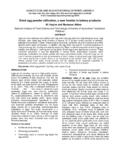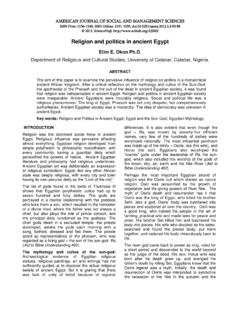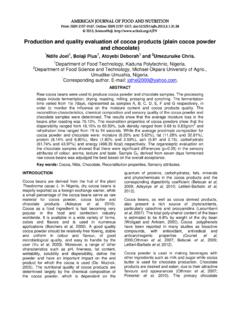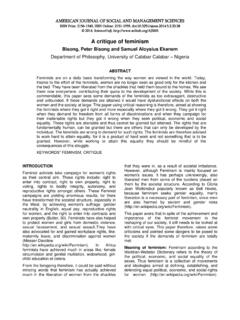Transcription of Financing of education in Nigeria: An analytical …
1 AMERICAN JOURNAL OF SOCIAL AND MANAGEMENT SCIENCES ISSN Print: 2156-1540, ISSN Online: 2151-1559, 2011, ScienceHu , Financing of education in nigeria : an analytical review Dr. T. O. Adeyemi Department of Educational Foundations & Management, P. M. B. 5363, University of Ado- Ekiti, nigeria . ABSTRACT In this article, the writer has examined the Financing of education in nigeria . A review of the finances on education since the advent of formal education in the country was made. The sources of Financing of education in developed and developing countries were highlighted while the Nigerian external debt stock and the level of debt servicing were given. The study has shown the total revenue accruing to the Federal Government and the amount of money allocated to the education at various periods indicating deficits in the funding of the system.
2 The findings indicated that the funding of education has not been up to 17% in any given year despite the UNESCO minimum standard of 26% of national budget. The writer therefore made suggestions on how to effectively fund education in the country and recommended other sources of funding education for future development. Keyword: Financing , education , nigeria , analytical , Review INTRODUCTION Public finance has been described as the collection and disbursement of funds for public use (Corbally, 1962, Osuntokun, 2003). It has also been regarded as the financial activities of public authorities in terms of taxing, spending, borrowing and lending and it involves the means of providing for the expenditure involved in the staffing, equipment and maintenance of educational institutions (Adesua, 1981, Charles, 2002).
3 The Financing of education as an aspect of public finance embraces all aspects of funding of education including the sources of funding and how the money earmarked for education is spent especially for the purchase of goods and the services of men and materials (Agbobu 1983, Borokhovich, Bricker, Zivney and Sundaram, 1995). Thus, the Financing of education is a vital area of Economics of education (Akangbou, 1986, Adeyemi, 1998). The importance of adequate Financing of education cannot be over-stressed. Ozigi (1977) argued that no organization could carry out its functions effectively without adequate financial resources at its disposal.
4 Money is needed to pay staff, maintain the plant and keep the services going. This argument supported earlier findings that finance is of vital importance to education and economic growth (Sheehan, 1973; Eaton, and Nofsinger, 2000; Taggert, 2003). Sources of Finance: Considering the sources of Financing education , Vaizey (1961) raised the question, how can education be financed? Answering the question, he argued that the Financing of education can be derived from fees paid by parents, repayable loans to parents, local government taxes, general budgetary funds, gifts and remission of taxes. Apart from direct tax, Vaizey (1962) mentioned indirect tax and property tax.
5 According to him, indirect taxation is a growing source of public finance while property tax is an important source of educational finance in countries with a decentralized educational system. Agreeing with this argument, UNESCO (1968) remarked that in developed countries, education is entirely financed by taxation, but in developing countries other sources could be explored. Thus, Thorniley (2003) recommended the use of graduate tax in the UK. Educational Expenditure : Educational expenditure as an aspect of educational finance deals with how the amount allocated to education is spent. It may be used not only as an instrument for analyzing financial aspects of education , but also as a parameter for projecting the trends of an educational system (Hallak, 1969).
6 Thus, one of the methods of determining the flow of educational finance is to study the time trend of educational expenditure. Supporting this point, Adesina (1982) reported that expenditure on education is determined by budgetary allocations. He described a budget as an estimate of revenues and expenditures for a given period of time, usually a twelve-month period called a financial year. Woodhall (1987) too, described a budget as a document containing recurrent and capital expenditures. According to her, recurrent or current expenditures include expenditures on consumable goods such as Am. J. Soc. Mgmt. Sci., 2011, 2(3): 295-303 296books, stationery and fuel as well as services which bring immediate or short-time benefits.
7 She also referred to capital expenditures as expenditures on durable assets such as buildings and equipment which are expected to yield benefits over a longer period. The same views were made by other researchers (Borokhovich, Bricker, Brunarski and Simkins, 1998), The measurement of expenditure includes the expenditure by pupils, their families, charities and the State. The total costs of education to an individual are divided into monetary expenditures borne by him and opportunity costs while the true economic cost of education is the cost of acting in a different manner, that is, foregoing the opportunity of doing one thing in order to do something else (Vaizey 1962; Chan, Chen, and Steiner, 2002).
8 Thus, in developing countries, Mingat and Tan (1986) reported that the share of education in public spending has already become very large, reaching between one tenth and one-third of public budget. Supporting this argument, Tilak (1988) found in India, that public costs per pupil are very high. In nigeria , Hinchliffe (1989) gave estimates of recurrent expenditures per pupil in four States based on aggregate statistics of expenditures and enrolment. His findings showed that the private contribution to costs is higher in the Southern States and this partly explains why their public costs are lower in the Northern States.
9 Contrary to what operates in many countries, Adedayo (1988) argued that although enrolment is increasing at the primary, secondary and tertiary levels of Nigerian educational system, government s expenditure is decreasing proportionately. He observed a sharp drop in the total capital expenditures between 1975 and 1983 and remarked that this might not have been unconnected with the economic depression which was compounded by the structural adjustment programme. Urwick (1993) supported this argument and remarked that such harsh economic conditions could raise correspondingly difficult issues for educational management.
10 Stages of Educational Financing in nigeria Period 1842 1900: Financing of education during this period was in the hands of the Christian Missionaries who owned and controlled schools for a long time. Schools were established by these voluntary agencies and maintained through school fees paid by parents, subscriptions from churches and grants from Missionary Societies. School fees were, however, extremely low during this period. The Wesleyan Missionary Society, for example, established and financed nigeria s first elementary school at Badagry in 1842 while the Church Missionary Society founded the C.






